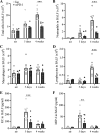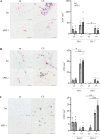Blockade of PD-1 decreases neutrophilic inflammation and lung damage in experimental COPD
- PMID: 33759577
- PMCID: PMC8424521
- DOI: 10.1152/ajplung.00121.2020
Blockade of PD-1 decreases neutrophilic inflammation and lung damage in experimental COPD
Abstract
Chronic obstructive lung disease (COPD) and lung cancer are both caused by smoking and often occur as comorbidity. The programmed cell death protein 1/programmed cell death ligand 1 (PD-1/PD-L1) axis is an important canonic immunoregulatory pathway, and antibodies that specifically block PD-1 or PD-L1 have demonstrated efficacy as therapeutic agents for non-small cell lung cancer. The role of the PD-1/PD-L1 axis in the pathogenesis of COPD is unknown. Here, we analyzed the function of the PD-1/PD-L1 axis in preclinical COPD models and evaluated the concentrations of PD-1 and PD-L1 in human serum and bronchoalveolar lavage (BAL) fluids as biomarkers for COPD. Anti-PD-1 treatment decreased lung damage and neutrophilic inflammation in mice chronically exposed to cigarette smoke (CS) or nontypeable Haemophilus influenzae (NTHi). Ex vivo stimulated macrophages obtained from anti-PD-1-treated mice released reduced amounts of inflammatory cytokines. PD-L1 concentrations correlated positively with PD-1 concentrations in human serum and BAL fluids. Lung sections obtained from patients with COPD stained positive for PD-L1. Our data indicate that the PD-1/PD-L1 axis is involved in developing inflammation and tissue destruction in COPD. Inflammation-induced activation of the PD-1 pathway may contribute to disease progression.
Keywords: COPD; PD-1; PD-L1; inflammation; lung damage; macrophages.
Conflict of interest statement
No conflicts of interest, financial or otherwise are declared by the authors.
Figures







Similar articles
-
Modulation of the PD-1/PD-L1 immune checkpoint axis during inflammation-associated lung tumorigenesis.Carcinogenesis. 2020 Nov 13;41(11):1518-1528. doi: 10.1093/carcin/bgaa059. Carcinogenesis. 2020. PMID: 32602900 Free PMC article.
-
Similar programmed death ligand 1 (PD-L1) expression profile in patients with mild COPD and lung cancer.Sci Rep. 2022 Dec 27;12(1):22402. doi: 10.1038/s41598-022-26650-9. Sci Rep. 2022. PMID: 36575294 Free PMC article.
-
IL-17C-mediated innate inflammation decreases the response to PD-1 blockade in a model of Kras-driven lung cancer.Sci Rep. 2019 Jul 17;9(1):10353. doi: 10.1038/s41598-019-46759-8. Sci Rep. 2019. PMID: 31316109 Free PMC article.
-
Inflammatory cells and chronic obstructive pulmonary disease.Curr Drug Targets Inflamm Allergy. 2005 Dec;4(6):607-18. doi: 10.2174/156801005774912824. Curr Drug Targets Inflamm Allergy. 2005. PMID: 17305517 Review.
-
Ongoing clinical trials of PD-1 and PD-L1 inhibitors for lung cancer in China.J Hematol Oncol. 2017 Jul 5;10(1):136. doi: 10.1186/s13045-017-0506-z. J Hematol Oncol. 2017. PMID: 28679395 Free PMC article. Review.
Cited by
-
Prognostic and predictive significance of soluble programmed death ligand 1 in bronchoalveolar lavage fluid in stage IV non-small cell lung cancer.Transl Lung Cancer Res. 2024 Aug 31;13(8):1888-1906. doi: 10.21037/tlcr-24-392. Epub 2024 Aug 23. Transl Lung Cancer Res. 2024. PMID: 39263019 Free PMC article.
-
Our evolving view of neutrophils in defining the pathology of chronic lung disease.Immunology. 2021 Dec;164(4):701-721. doi: 10.1111/imm.13419. Epub 2021 Oct 4. Immunology. 2021. PMID: 34547115 Free PMC article. Review.
-
PD-L1 and PD-1 expression in thyroid follicular epithelial dysplasia: Hashimoto thyroiditis related atypia and potential papillary carcinoma precursor.APMIS. 2022 May;130(5):276-283. doi: 10.1111/apm.13218. Epub 2022 Mar 13. APMIS. 2022. PMID: 35238073 Free PMC article.
-
PD-1+ T lymphocyte proportions and hospitalized exacerbation of COPD: a prospective cohort study.Respir Res. 2024 May 24;25(1):218. doi: 10.1186/s12931-024-02847-6. Respir Res. 2024. PMID: 38789950 Free PMC article.
-
miR449 Protects Airway Regeneration by Controlling AURKA/HDAC6-Mediated Ciliary Disassembly.Int J Mol Sci. 2022 Jul 13;23(14):7749. doi: 10.3390/ijms23147749. Int J Mol Sci. 2022. PMID: 35887096 Free PMC article.
References
Publication types
MeSH terms
Substances
LinkOut - more resources
Full Text Sources
Other Literature Sources
Medical
Research Materials

